
A child’s book of saints, illustrated by Thomas Robinson, title page
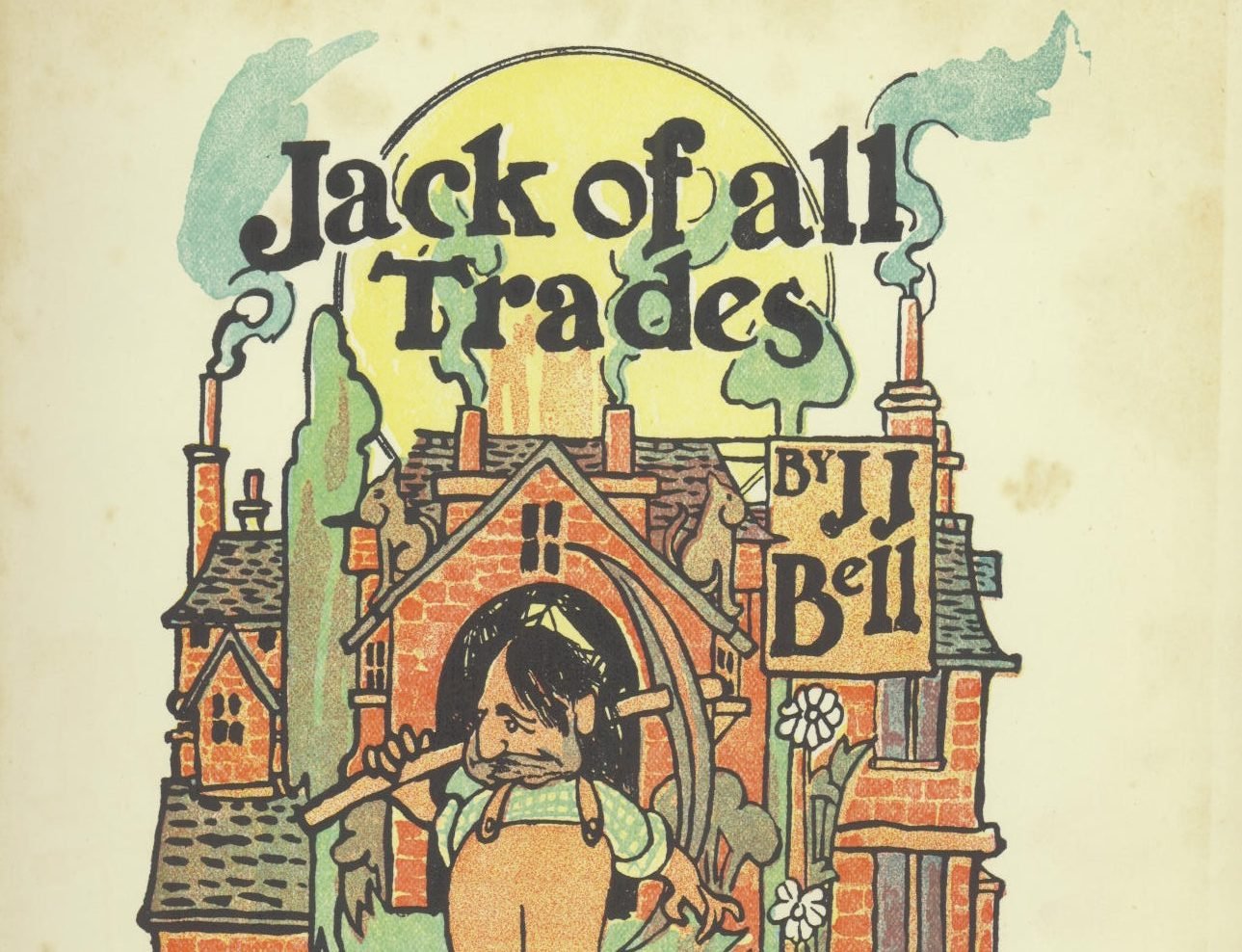
Jack of all trades, illustrated by Charles Robinson, title page
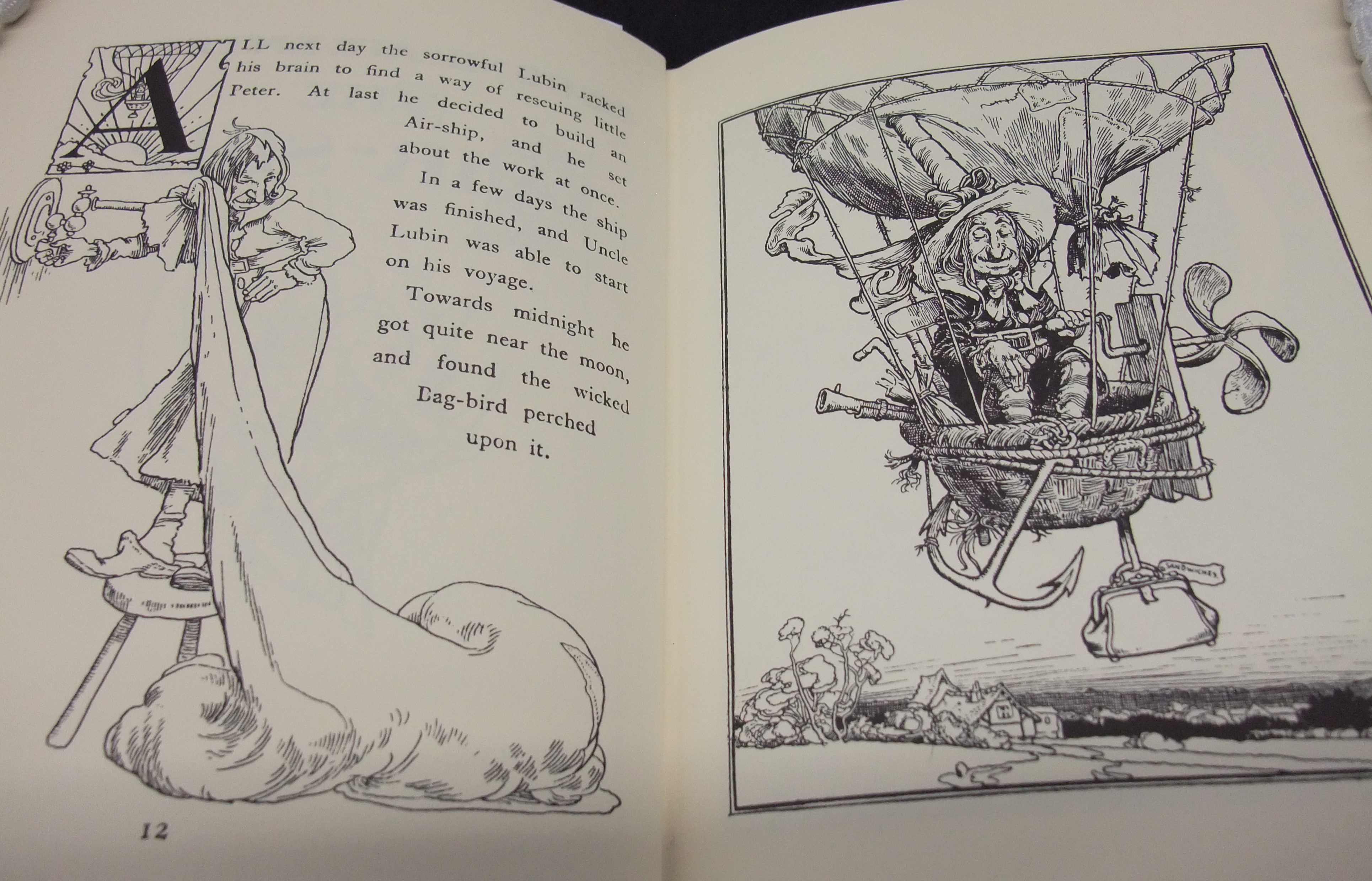
The adventures of Uncle Lubin, illustrated by William Heath Robinson, pp 12-13
Alexander Dumas’ romantic adventure The three musketeers (1844) set in seventeenth century France describes ‘three inseparables’ of the Musketeers of the Guard, an elite corps who defend the honour of their regiment. The Robinson brothers Thomas (1869–1954), Charles (1870–1937) and William Heath (1872–1944) delighted in applying this analogy to themselves, as David Larkin in Charles and William Heath Robinson suggests, they had a personal commitment to each other spending much of their early adult life in their father’s studio and later shared studios with one another. Their impact on the Golden Age of children’s book illustration was quite different from that of the three most notable artists of this period: Arthur Rackham, Edmund Dulac and Kay Nielsen, evidenced in this selection of their children’s books.
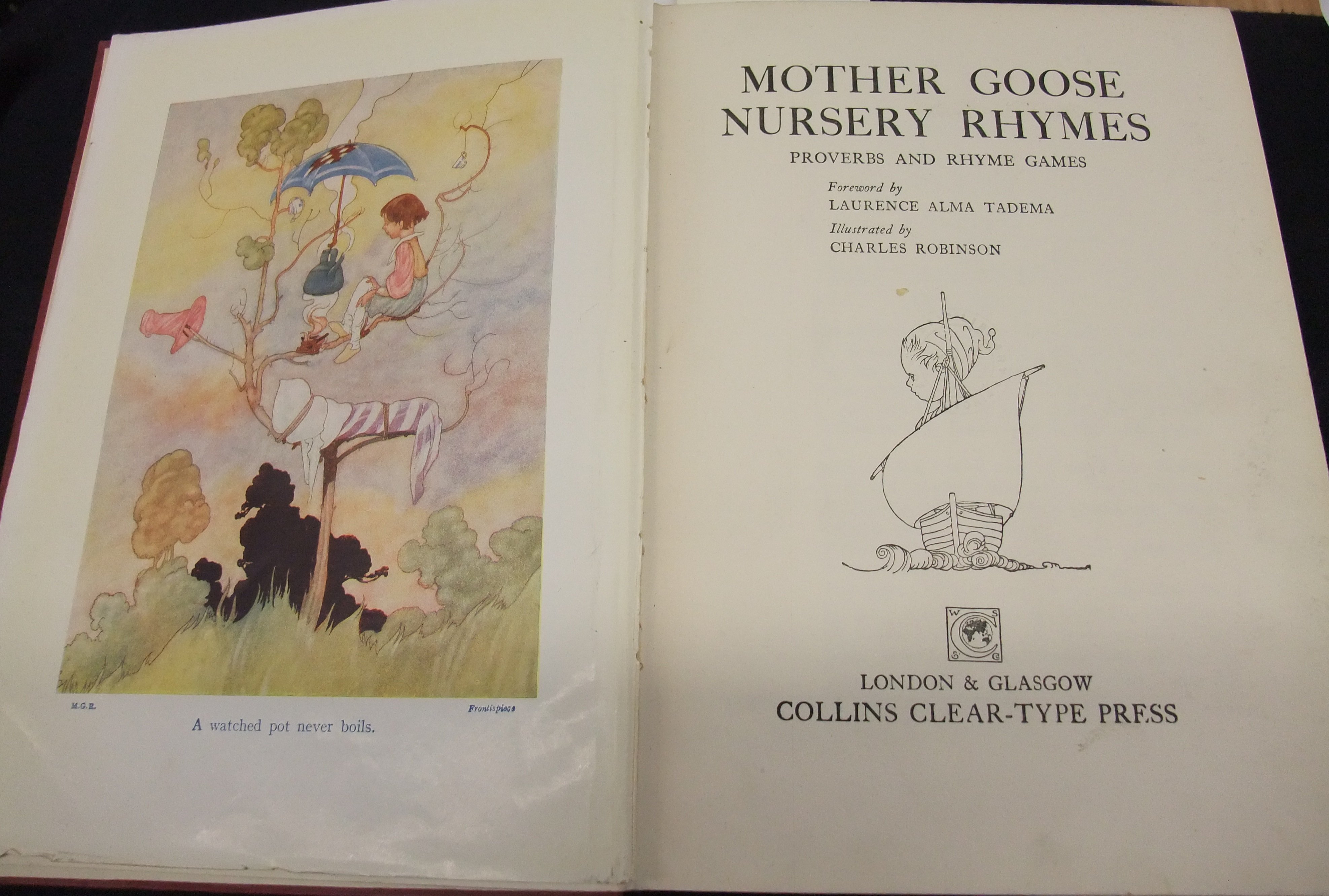
Mother Goose nursery rhymes, illustrated by Charles Robinson, title page
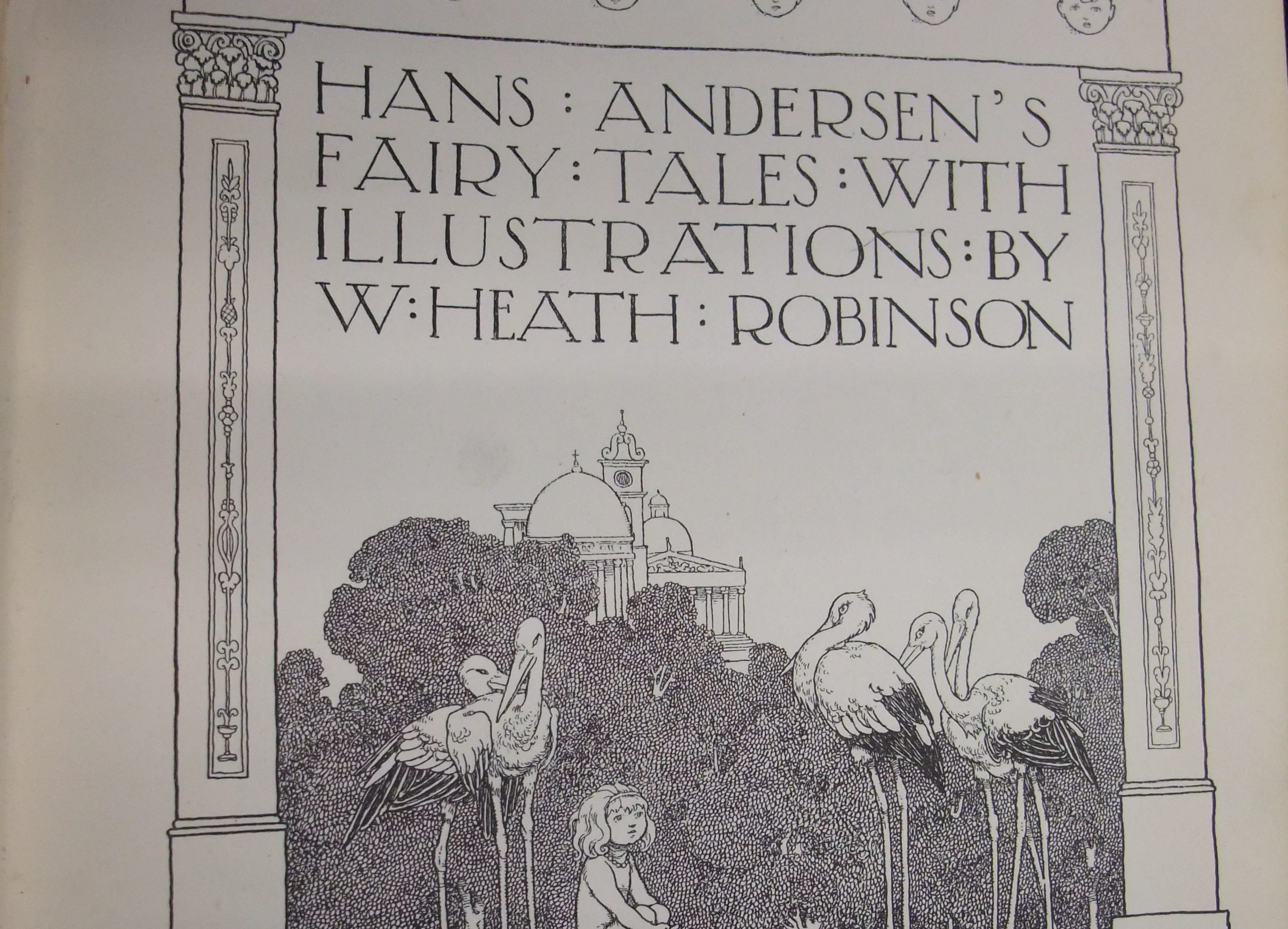
Hans Andersen fairy tales, illustrated by William Heath Robinson, title page
The Robinson brothers followed their familial forebears artistically. Their father and uncle were illustrators for prominent London newspapers. The patriarch of the family was the boys’ grandfather Thomas Robinson who was a bookbinder to among others Thomas Bewick, the nineteenth century British engraver responsible for popularising a technique of cross grain wood block printing.
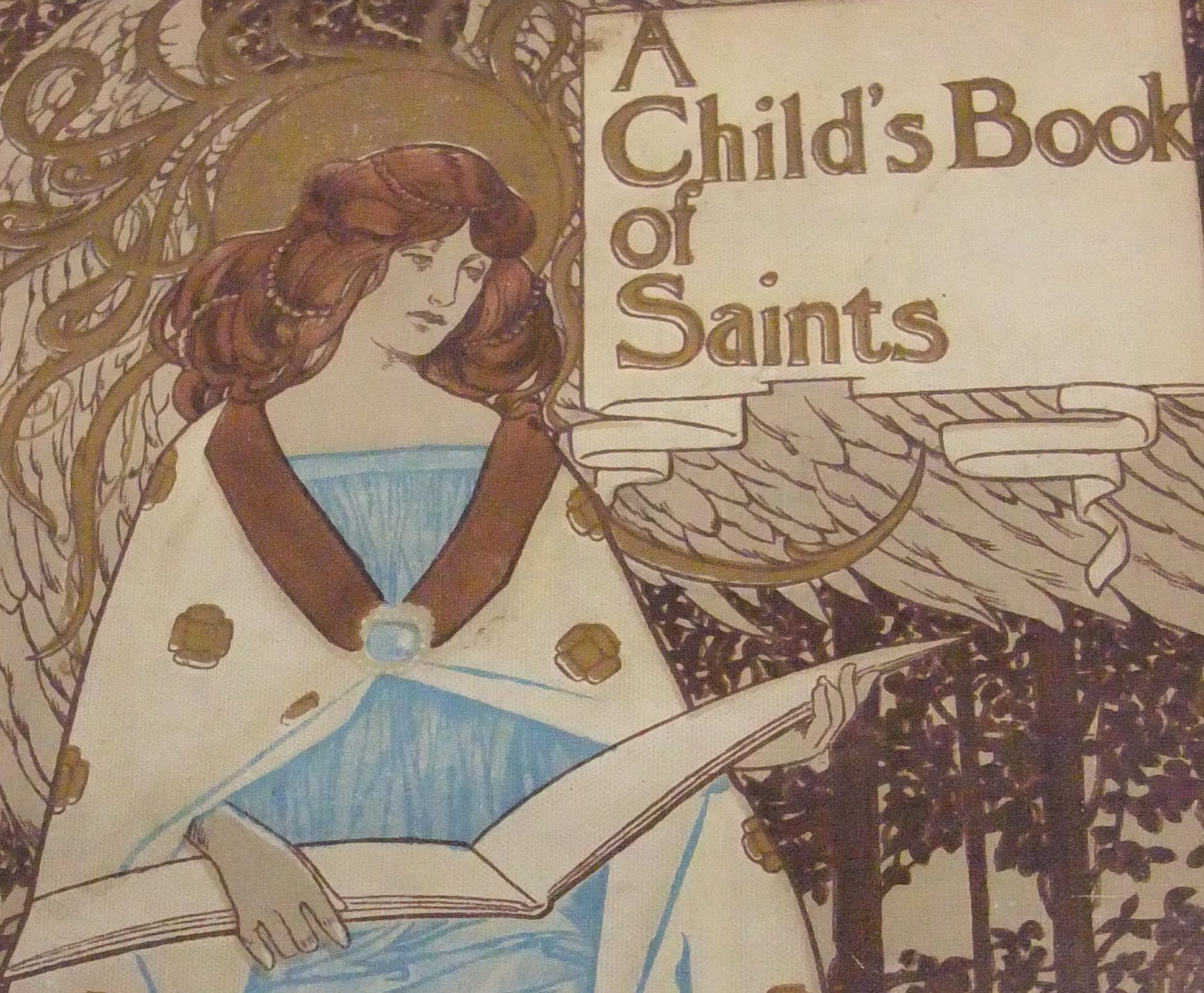
A child’s book of saints, illustrated by Thomas Robinson, cover
The eldest brother Thomas was an artist who specialised in black and white pen and ink work in books and magazines. Thomas was not renowned for his children’s book illustrations but in 1898 his images accompanied A child’s book of saints, a solemn tome compared to the playful works for children of his younger brothers. The majority of Thomas’ drawings are found in illustrated journals. Early in the Victorian period English illustrated newspapers and journals first appeared, increasing in output and popularity by the 1890s.

A midsummer night’s dream by William Shakespeare, illustrated by William Heath Robinson, cover
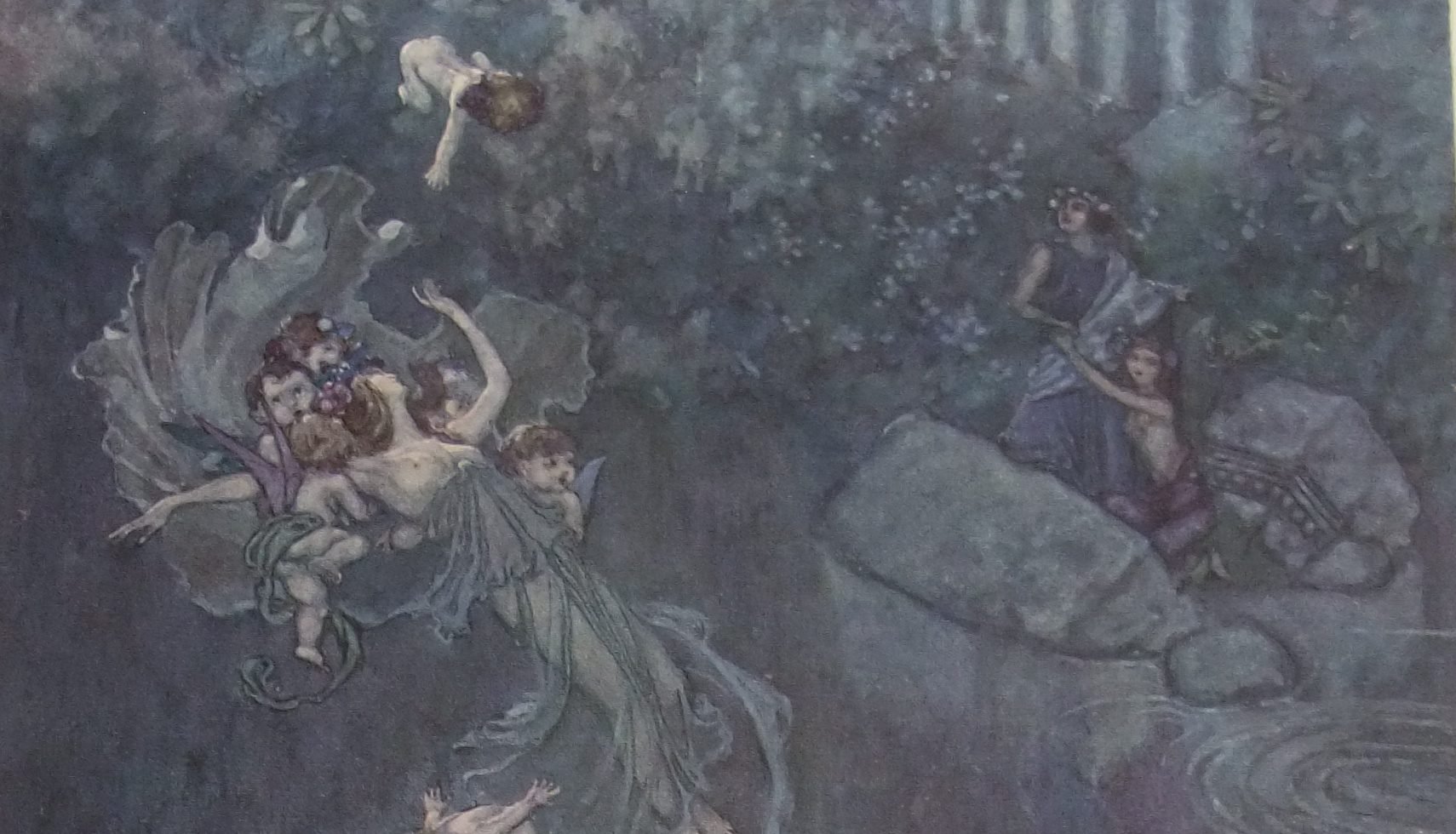
A midsummer night’s dream, by William Shakespeare, illustrated by William Heath Robinson, frontispiece
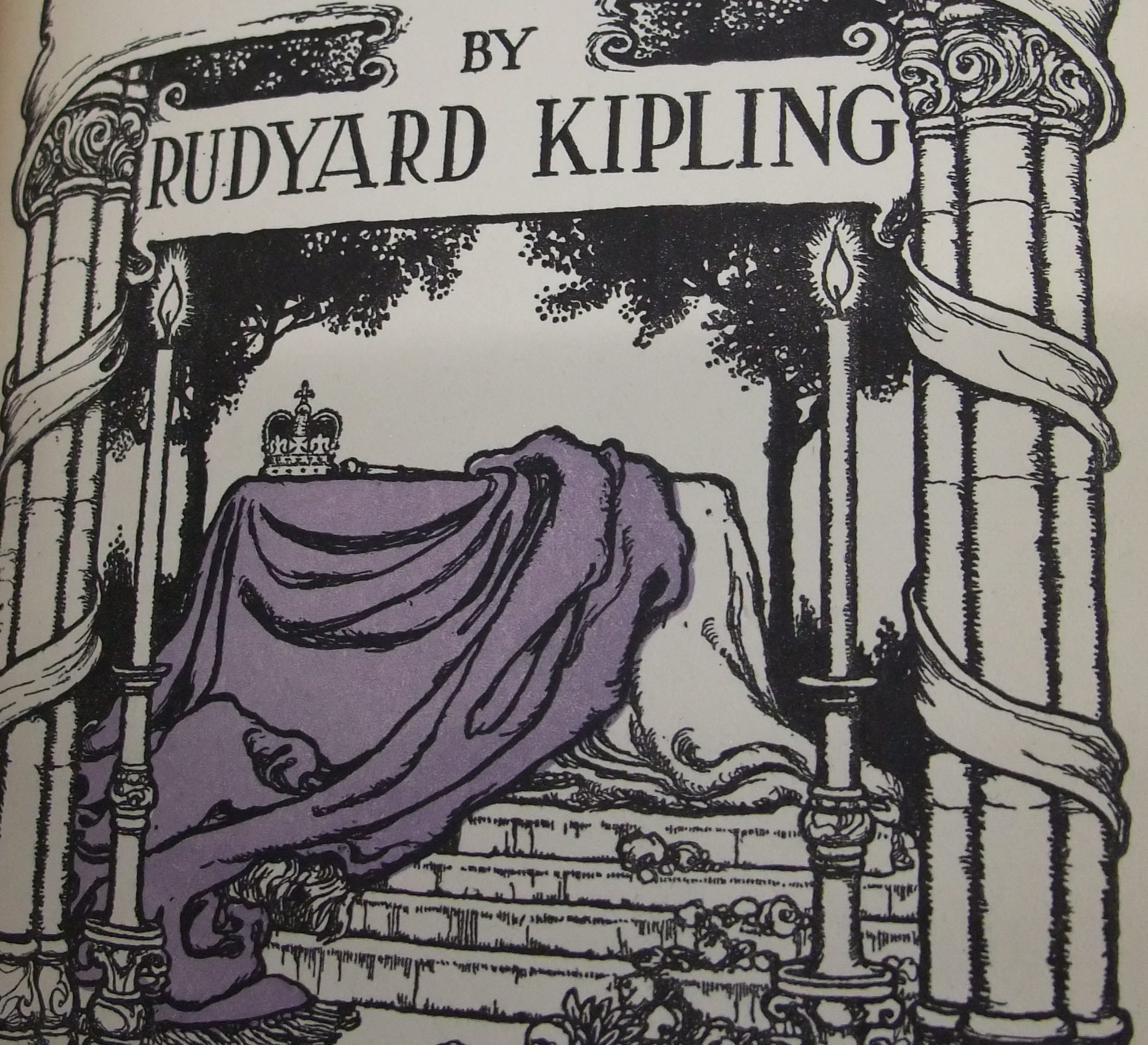
The dead king, by Rudyard Kipling, illustrated by William Heath Robinson, title page
While Charles and William Heath (commonly shortened to Heath) illustrated a range of children’s books, all three brothers illustrated works for adult readers, including those by Shakespeare, Kipling as well for the British Strand magazine: an illustrated monthly.
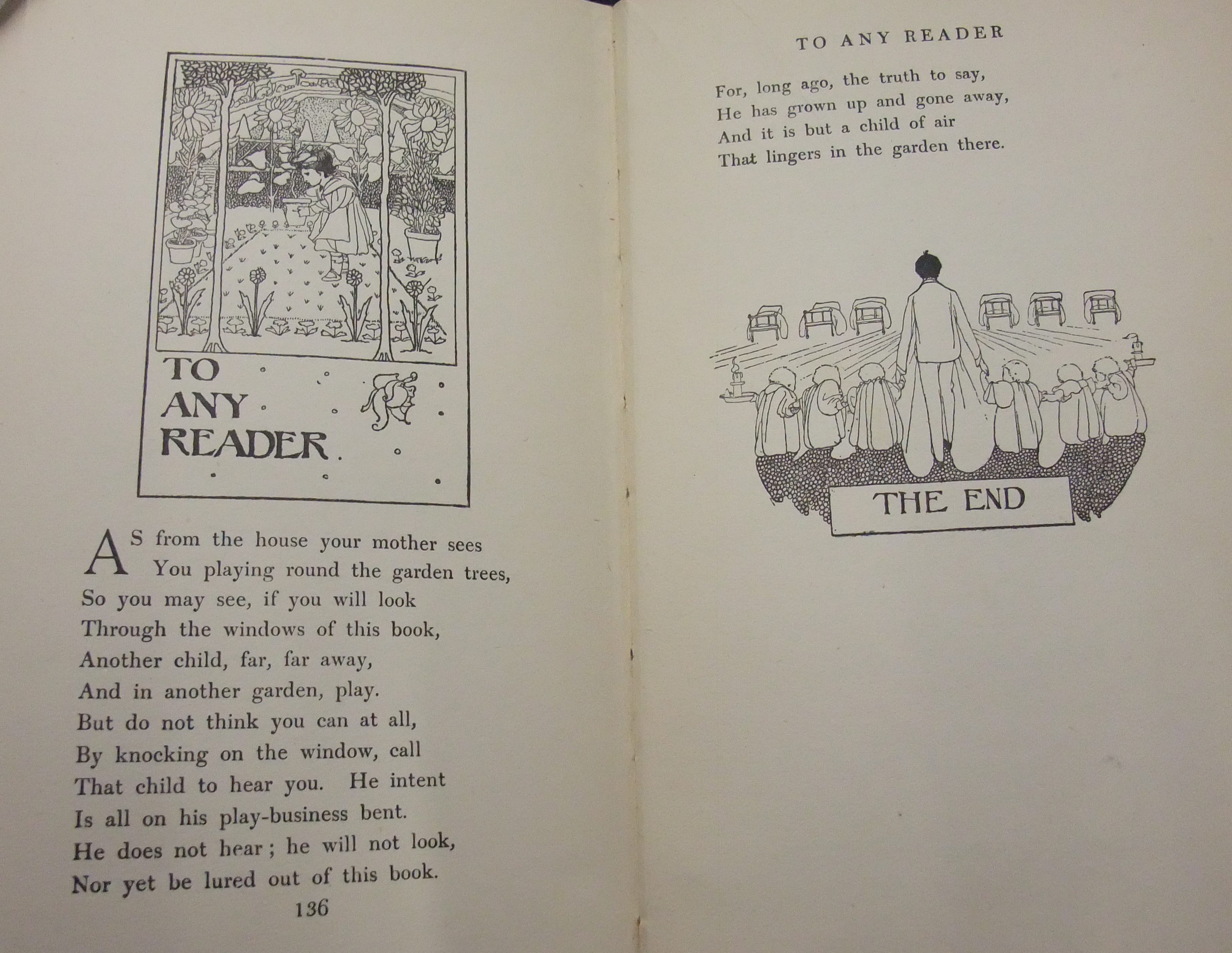
A child’s garden of verses by Robert Louis Stevenson, illustrated by Charles Robinson, The Moon pp 136-137
Charles achieved popularity with his black and white illustrations to Robert Louis Stevenson’s A child’s garden of verses first published in 1895. His career illustrating nursery rhymes, fables and fairy stories developed characteristically with sympathetic depictions of childhood. He renders sinister or frightening situations with gentle, balanced elegance suggesting no real threat to readers.

Artists, from Jack of all trades, illustrated by Charles Robinson, pp 52-53

Phrenologist from Jack of all trades, illustrated by Charles Robinson, pp. 6-7
In Jack of all trades Charles’ illustrations accompany the humorous verse by John Joy Bell (1871–1934), the Scottish journalist and author. Bell’s articles in the Glasgow Evening Times and Scots Pictorial commonly describe the life of working class Glaswegians. Charles’ illustrations match Bell’s irreverence in their portrayal of occupations from the bizarre Phrenologist to the familiar yet eccentric Artist shown here.
The youngest brother, Heath, first aspired to be a landscape painter and this remained so throughout his life. After leaving art schools in Britain in 1895, including the Royal Academy, he spent a summer on Hampstead Heath painting and sketching but his attempts to sell his work were largely unsuccessful. Thomas and Charles had already established themselves as book illustrators, and Heath decided it was wisest for him to follow suit.

The adventures of Uncle Lubin, by William Heath Robinson, cover
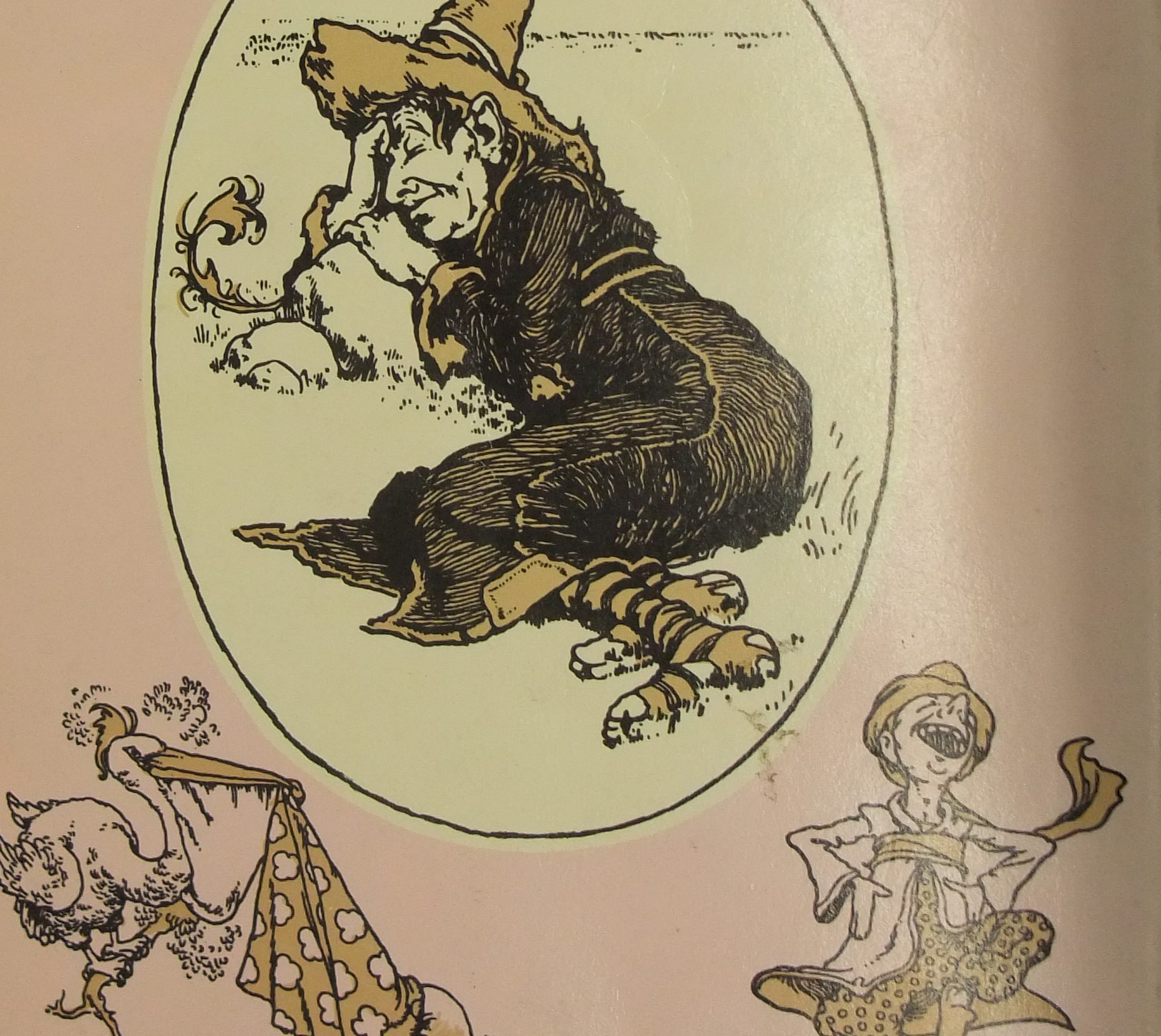
The adventures of Uncle Lubin, by William Heath Robinson, back cover
Heath’s first commissions were to illustrate magazines and reprints of classics. Children’s book commissions followed and in 1902 he wrote a children’s book of his own: The adventures of Uncle Lubin. This is the story of a man in a tall hat and long coat, as he tries to rescue his nephew who has been stolen by a wicked bag-bird. Heath referred to his Uncle Lubin character as the strange little genius who tempted Heath along a path independent of his more serious work. In this book, as with many illustrations, Heath created a rough sketch of the central character, then he would develop facial expressions, eccentric clothing and proceed to exaggerate his composition to absurdity. His captions contained puns equally absorbing as the visual puns.

Hans Andersen’s fairy tales, illustrated by William Heath Robinson, plate opp p 56 Caption: ‘She stood at the door and begged for a piece of barley-corn’ from Tommelise
Heath professed to love illustrating children’s books because creatively he didn’t feel the necessity to restrict himself and could be spontaneous with his images. His son Oliver, in his introduction to The illustrations of W. Heath Robinson, said his father was always happy in their home and he and his siblings could be assured that ‘solemn nonsense was seldom far away’ (p ix). Similarly Heath’s own childhood was relaxed and happy and he valued the companionship of his older brothers Thomas and Charles.
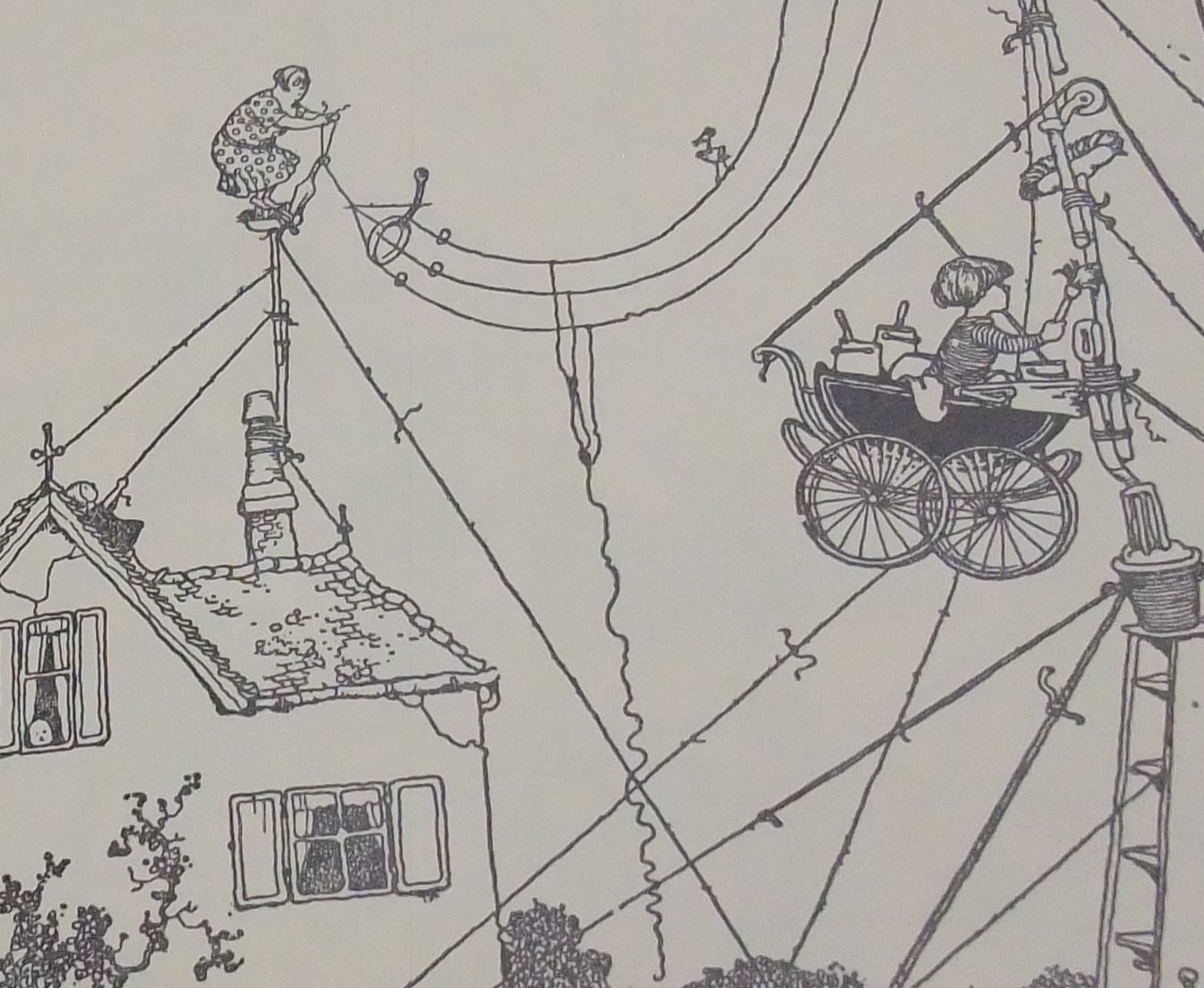
The wireless adventures of Mr Pimple, illustrated by William Heath Robinson. Caption: Mr Pimple begins with the aerial– not forgetting a coat of paint’.
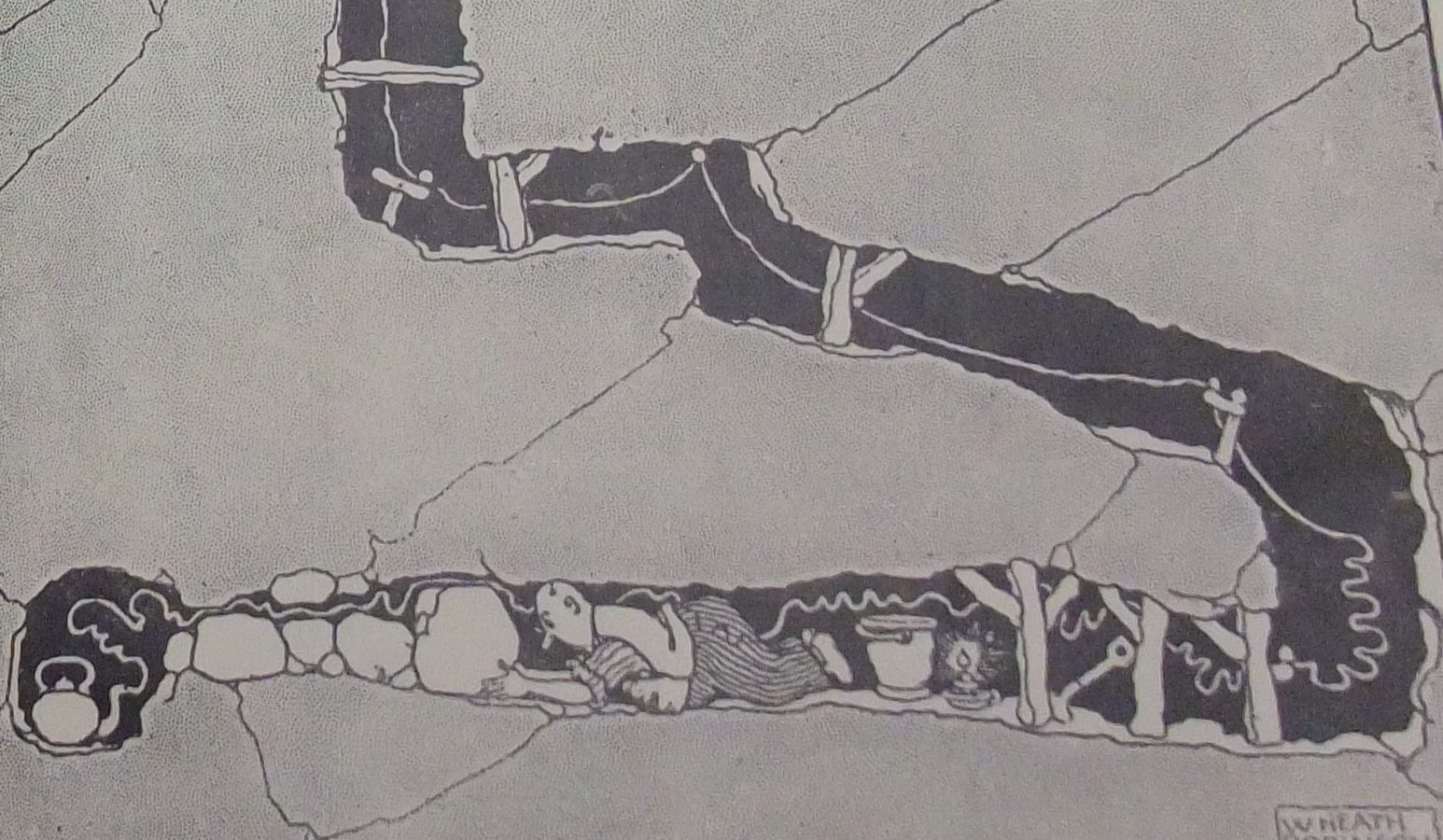
The wireless adventures of Mr Pimple, illustrated by William Heath Robinson. Caption: ‘Mr Pimple now carefully earths the earth wire’.
During WWI Heath Robinson almost entirely drew comic anti-German cartoons that were first published as Some ‘frightful’ war pictures, in 1915. These images are humorous rather than malicious and were designed to sustain the morale of British troops at the front. Then in the 1920s a long succession of commercial firms invited him to contribute to their advertisements by imaginatively illustrating their manufacturing processes.
In The wireless adventures of Mr Pimple he uses the cartoon format to explore the ramifications and applications of a single idea. His humour lies in his observation of ordinary people, especially those who take themselves very seriously. In his contraptions he depicted the absurd lengths to which one can go to achieve the most trivial of ends. His satires expose human foibles and weaknesses and his humour centres on the human condition and the weaknesses and self-importance of man rather than the gadgets and contraptions he has become synonymous with.
This blog continues the Library’s series on children’s book artists of the first decades of the twentieth century when publishers created sumptuous productions known as Gift Books designed to showcase the artwork of what became known as the Golden Age of children’s book illustration.
References
- Charles and William Heath Robinson, by David Larkin, constable, London, 1976
- Exhibition of Heath Robinson works, website
- The illustrations of W Heath Robinson, by Geoffrey Beare, Werner, London, 1983
- Images of Charles Robinson’s artwork, website
- Influences on the work of Charles Robinson, website
- Influences on the work of William Heath Robinson, website
- Inventions, by W Heath Robinson, Duckworth, London, 1973
- My line of life, by W Heath Robinson, Blackie & Son, London, 1938.


Gracias por la informacion!! Este tipo de blogs me parecen muy importantes, esto lo estudio en la universidad. gracias por la informacion. https://uautonoma.cl
Beautiful, I’ve enjoyed reading. I well remember the name Heath Robinson – not sure if it was my grandmother or my father. I’m sure someone has alerted you to ‘Health’!
Hi Margaret,
Thanks for your feedback Margaret. I enjoyed researching the Robinson brothers and their works for children.
cheers,
Juliet
Oh I’d love to see these exhibitions, so glad I received your email, thank you very much.
Apeetha Arunagiri
Hi Apeetha,
I’m glad you enjoyed this blog post. All the items are available in the State Library Victoria, unfortunately not as an exhibition. Instead this blog sets a context with further reading if you’d like to explore more.
cheers,
Juliet
I am delighted to read about the brothers and I first heard Heath’s name because of his zany contraptions – wonderful man! Juliet, I loved looking at the illustrations; I have got two books at home with pictures by Arthur Rackham – one very old copy belonged to my late mother (J.M. Barrie’s Peter Pan in Kensington Gardens), the other book a 1977 reprint (Alice’s Adventures in Wonderland).
Thank you for sharing these.
Hi Sally,
I’m glad you enjoyed reading about the Robinson brothers. I certainly enjoyed researching them and their children’s books. Your Rackham books could be the start of a collection!
Cheers,
Juliet